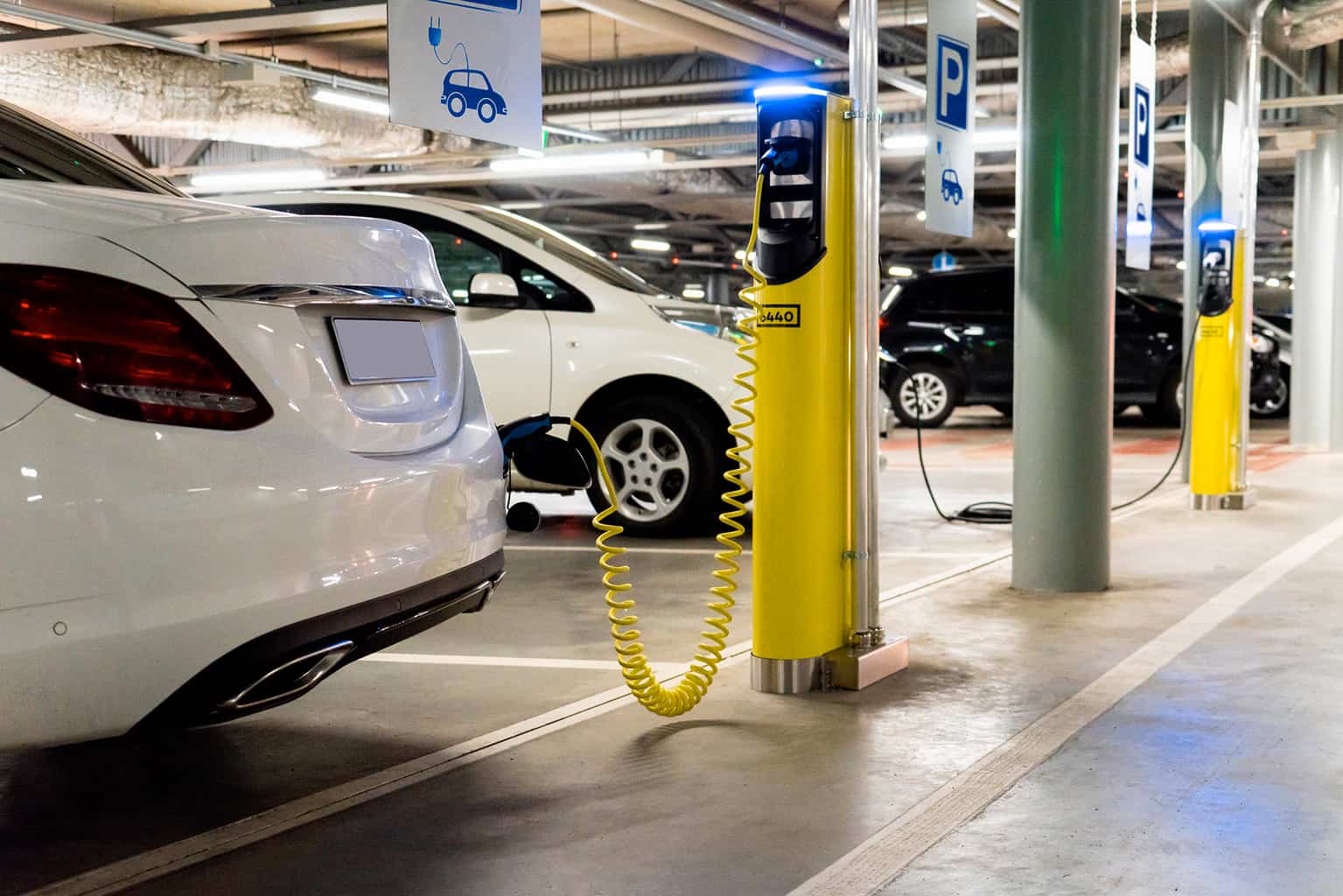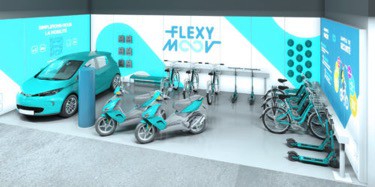
What is the link between buildings and mobility?
4 minutes of reading
In theory, there is none … The world of mobility is changing and is no longer limited to transport.

Mobility shapes our way of living and is omnipresent in our daily lives. Stakeholders in real estate and urban planning have understood this and are developing uses by increasingly integrating the subject of mobility into building designs. In addition to meeting societal expectations, the convergence of buildings and mobility also responds to an ecological issue. The building and mobility sectors together account for 80% of global energy consumption; they are responsible for 49% of GHG production and 70% of CO2 production. The merging of these two sectors is thus a real ecological lever, but also an economic one given that they consume a significant slice of French household budgets.
 The solution entails setting up a “Flexy Centre” in the company’s car park. Then, through a dedicated app, employees can choose the mode of transport among those available that best suits their journey. On offer are cars, bikes, mopeds, and electric kick scooters.
Flexy Moov takes care of vehicle maintenance and insurance. It also provides users with assistance and safety kits. The advantages for companies and users include fewer parking spaces (as employees no longer feel the need to use their vehicle), reduced travel costs, and time savings. By promoting the use of electric modes, Flexy Moov is helping to reduce the number of conventional combustion-engine vehicles, which are increasingly incompatible with the challenges associated with air quality and climate. Today, one in three young people consider a company’s sustainable development policy as an essential criterion in their choice of employer. This solution helps companies be more environmentally responsible and comply with various legislation, all while improving both their image and their employees’ quality of life at work.
In conclusion, mobility is hugely influential in real estate; buildings and their mobility services must simultaneously meet the expectations of end users and help tackle international issues. The successful convergence of these two sectors will go towards achieving the objective of reducing greenhouse gas emissions, which is a necessary step in limiting global warming.
The solution entails setting up a “Flexy Centre” in the company’s car park. Then, through a dedicated app, employees can choose the mode of transport among those available that best suits their journey. On offer are cars, bikes, mopeds, and electric kick scooters.
Flexy Moov takes care of vehicle maintenance and insurance. It also provides users with assistance and safety kits. The advantages for companies and users include fewer parking spaces (as employees no longer feel the need to use their vehicle), reduced travel costs, and time savings. By promoting the use of electric modes, Flexy Moov is helping to reduce the number of conventional combustion-engine vehicles, which are increasingly incompatible with the challenges associated with air quality and climate. Today, one in three young people consider a company’s sustainable development policy as an essential criterion in their choice of employer. This solution helps companies be more environmentally responsible and comply with various legislation, all while improving both their image and their employees’ quality of life at work.
In conclusion, mobility is hugely influential in real estate; buildings and their mobility services must simultaneously meet the expectations of end users and help tackle international issues. The successful convergence of these two sectors will go towards achieving the objective of reducing greenhouse gas emissions, which is a necessary step in limiting global warming.
So how can mobility be incorporated into real estate projects?
Last December, the Bouygues Group, the Movin’On sustainable mobility ecosystem led by Michelin, the Renault group, Schneider Electric, the Smart Buildings Alliance for Smart Cities (SBA), and their partners formed the first consortium on the building-mobility convergence, with the aim of setting up “a shared framework” called Ready4Mobility. According to the consortium, integrating electric mobility into buildings can respond to both the needs of citizen users and to global environmental and societal challenges. “This framework is designed to be a guide to help building and mobility stakeholders take full advantage of digital technology to transform buildings into real mobility service platforms that are scalable, comfortable and in line the smart and sustainable city model. It is also intended to be a tool to promote the most advanced plug & play projects in this digital integration, in order to offer increasingly comprehensive building and mobility service packages, based on sharing and pooling,” explains Emmanuel François, Chairman of the SBA. The working group will have to develop energy ecosystems for the building-mobility convergence in order to meet the challenges related to production, storage, load management and the energy balance of the building-electric vehicle merger. Other areas requiring further consideration include defining an economic model and working on the legal and regulatory environment. “The challenge of the Building-Mobility convergence lies in reconciling the transition towards shared electric mobility (EV) and the capacity of buildings to manage EV fleets while maintaining their energy load curve,” says Fabrice Bonnifet, Sustainable Development & QSE Director of the Bouygues Group. In the automotive industry, electric mobility has already been considered: electric vehicles, with their batteries, can provide the city of the future with certain services, such as smart charging to balance consumption peaks, and two-way charging. Cars can thus be used as a means of energy storage, which is very expensive for buildings. And in turn, positive-energy buildings could recharge cars using their production surpluses.Mobility shaping real estate projects
On a slightly different note, some real estate projects have incorporated a large degree of soft mobility in their designs, such as the BikeCiti project in Vienna. Launched in 2008, this real estate project has over 330 bicycle parking spaces for 100 homes. The size of the lifts make it possible to transport bicycles to the building’s floors. An exemption over car parking spaces was granted, allowing the savings to be reinvested in the creation of shared spaces. Building design, shared spaces and car parks that encourage sharing and the use of sustainable modes, are all levers that support changes of practice. Offering building-related mobility services (such as mobility packs, recharging options for electric vehicles, mobile service platforms, data structures, self-driving local shuttles, etc.) offers an alternative to the use of private cars. Integrating electromobility or micromobility into buildings of the future also means rethinking the use of car parks. These spaces can offer new services to the building’s users. An example is that of the start-up Flexy Moov. Since May 2018, it has been offering businesses the chance to enhance their car parks by adding a mobility service for employees. The solution entails setting up a “Flexy Centre” in the company’s car park. Then, through a dedicated app, employees can choose the mode of transport among those available that best suits their journey. On offer are cars, bikes, mopeds, and electric kick scooters.
Flexy Moov takes care of vehicle maintenance and insurance. It also provides users with assistance and safety kits. The advantages for companies and users include fewer parking spaces (as employees no longer feel the need to use their vehicle), reduced travel costs, and time savings. By promoting the use of electric modes, Flexy Moov is helping to reduce the number of conventional combustion-engine vehicles, which are increasingly incompatible with the challenges associated with air quality and climate. Today, one in three young people consider a company’s sustainable development policy as an essential criterion in their choice of employer. This solution helps companies be more environmentally responsible and comply with various legislation, all while improving both their image and their employees’ quality of life at work.
In conclusion, mobility is hugely influential in real estate; buildings and their mobility services must simultaneously meet the expectations of end users and help tackle international issues. The successful convergence of these two sectors will go towards achieving the objective of reducing greenhouse gas emissions, which is a necessary step in limiting global warming.
The solution entails setting up a “Flexy Centre” in the company’s car park. Then, through a dedicated app, employees can choose the mode of transport among those available that best suits their journey. On offer are cars, bikes, mopeds, and electric kick scooters.
Flexy Moov takes care of vehicle maintenance and insurance. It also provides users with assistance and safety kits. The advantages for companies and users include fewer parking spaces (as employees no longer feel the need to use their vehicle), reduced travel costs, and time savings. By promoting the use of electric modes, Flexy Moov is helping to reduce the number of conventional combustion-engine vehicles, which are increasingly incompatible with the challenges associated with air quality and climate. Today, one in three young people consider a company’s sustainable development policy as an essential criterion in their choice of employer. This solution helps companies be more environmentally responsible and comply with various legislation, all while improving both their image and their employees’ quality of life at work.
In conclusion, mobility is hugely influential in real estate; buildings and their mobility services must simultaneously meet the expectations of end users and help tackle international issues. The successful convergence of these two sectors will go towards achieving the objective of reducing greenhouse gas emissions, which is a necessary step in limiting global warming.
More reading
Read also




What lies ahead? 7 megatrends and their influence on construction, real estate and urban development
Article
20 minutes of reading

